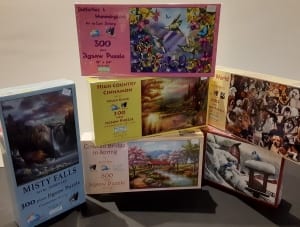Jigsaw Puzzles and Life — Putting Together the Pieces

Somehow, all the disparate pieces of a jigsaw puzzle fit together to create a whole image — kind of like life.
How you approach putting together a jigsaw puzzle says a lot about you.
Of course, how we approach any project says a lot about us, but for now, we’re talking about dumping a box of disparate pieces onto the table, organizing them into some semblance of order, and reassembling them so that they look like the picture on the box.

Animals, places, quilts and faces. The image of jigsaw puzzle we choose to put together depends upon our likes and preferences.
Some people, when it comes to the “organizing them into some semblance of order” part, get very precise. They seek out the edge pieces, hone in on the corners, and create piles of the rest according to color and form. Others dive right in and match piece with piece. If shapes are still stuck together from the manufacturing process, some people insist that they be separated and mixed back into the box. It’s only fair, they reason.
Others say, “If we’ve got 1000 pieces to put together, why not take advantage of any advantage we’ve got?”
No Rules
I know one man who, when he assembles a puzzle, refuses to look at the box, other than a first glance to see what the eventual goal is. His girlfriend prefers to refer to the image. Neither approach is “right” or “wrong,” just different, a celebration of individuality that encourages us to
- Be polite about other people’s way of doing things,
- Remain open to trying things a different way,
- Recognize that there is more than one way to achieve a goal, and
- Accept that rules are not unalterably sacrosanct.
Imagine that — life lessons from a jigsaw puzzle.
But there’s more — one of the most intriguing things I’ve found about jigsaw puzzles is that, though they seem to be nothing more than a jumbled series of random shapes that have little to do with one another, those pieces all fit together, eventually, to make that picture on the box. When we start, it’s easy to despair that we will ever finish, especially when the image has little contrast or distinctive shapes and colors. (There’s another preference: some people gravitate toward homogeneous images, like a pile of Snickerdoodle cookies or a night sky. Others recoil from such visual uniformity.)
Lessons of Life from a Jigsaw Puzzle

Only 300 pieces? Don’t underestimate the complexity of a puzzle with fewer pieces. The dog puzzle on the right is delightfully challenging.
But we start, and the more we work on the puzzle, the more familiar we become with the parts. Eventually, something clicks in our brain, saying, “That vibrant blue — it’s connected with that odd vase in the corner somehow.”
And oh, what a feeling of satisfaction when the pieces neatly slide together! In the bigger sphere of life, this happens when a seemingly random fact fits into other information we hold, with a resulting Aha moment: “THAT’S what the writer meant!” But we generally don’t experience this unless we’re reading and re-reading, analyzing and questioning, playing with the facts and the pieces.

Little children can be surprisingly good at putting together puzzles, even if — maybe especially when — they don’t follow the rules we adults feel compelled to impose.
Another intriguing element: jigsaw puzzles are companionable projects, providing we remember Points 1-4 above. It’s remarkably comforting to know that, while we’re putting together the trio of horses in the bottom right, another person is tackling the cloudy sky above. We realize, if only for this pleasurable moment, that it’s not all up to us, with nothing getting done unless we’re doing it. While we’re washing the dishes, someone else is sweeping the floor. It is a form of teamwork that is natural and normal, resulting in a finished project about which we feel good.
Quiet Concentration
Not to be discounted is the element of concentration jigsaw puzzles demand of our minds. Unlike watching TV, putting together a puzzle is not a passive endeavor, requiring nothing more than staring at a screen. Each piece has its place, and it won’t find it without a human hand putting it there. And while it may seem trivial to focus so much attention on interlocking all the red and white pieces into a panoply of roses, there’s nothing trivial about letting our minds ruminate in a gentle, quiet, and peaceful state.
The moment comes for the last piece. And then . . . what? Do we immediately dismantle the project and tumble it back in the box? Do we take a picture of it and send it to friends? Or how about carefully transporting it downtown to get it framed, an unusual piece of art in which we have had some part to play? Again, it depends upon the individual, and the circumstances.
That’s the beauty of jigsaw puzzles. In order to fully enjoy them, you really can’t confine them to a box. They’re like people that way.
 The Art of Jigsaw Puzzles is the featured Art Event at Wenaha Gallery from January 12 through February 9, 2021.
The Art of Jigsaw Puzzles is the featured Art Event at Wenaha Gallery from January 12 through February 9, 2021.
Contact the gallery, located at 219 East Main Street, Dayton, WA, by phone at 509.382.2124 or e-mail art@wenaha.com. Gallery hours are 9 a.m. to 5 p.m. from Monday through Friday, and by appointment. Visit the Wenaha Gallery website online at www.wenaha.com.


